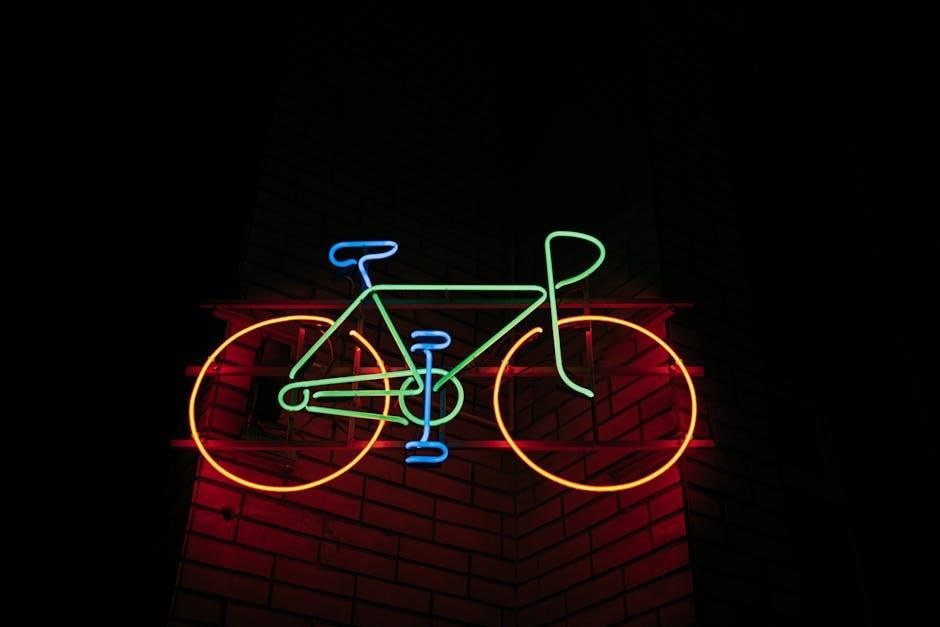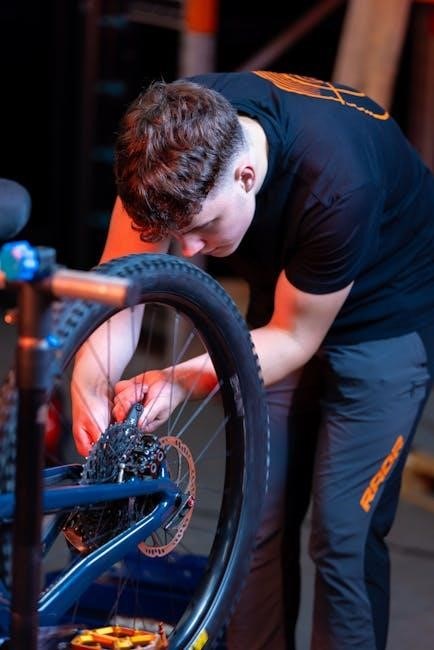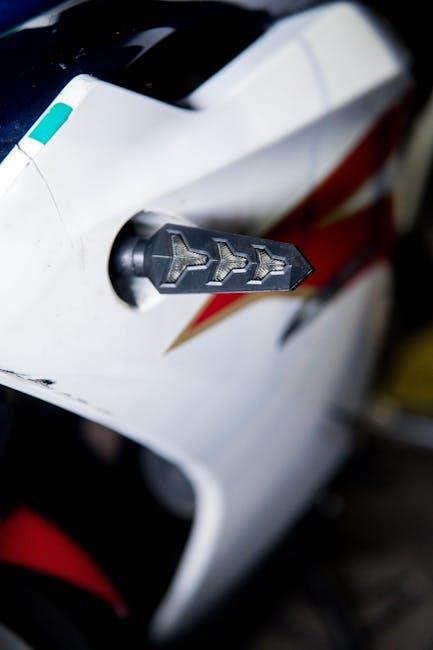Common Electric Bike Issues and Their Solutions
Electric bikes often face issues like battery drainage, motor noise, or brake malfunctions. Regular maintenance, such as checking connections and lubricating parts, can prevent these problems. Troubleshooting steps like diagnosing error codes or inspecting wires are essential for resolving issues promptly and ensuring safe, efficient rides.
- Battery-related problems, such as charging failures or reduced capacity, often stem from faulty connections or overcharging.
- Motor malfunctions, including unusual noise or vibration, can result from worn gears or loose bolts.
- Brake system failures may arise from misaligned pads or sensor issues, requiring immediate attention for safety.
- Display or controller issues, like error codes or connectivity problems, can disrupt ride performance and require software updates.
Addressing these common issues through proper troubleshooting and maintenance ensures optimal performance and extends the lifespan of your electric bike.
1.1 Battery-Related Problems
Battery issues are common in electric bikes, often caused by faulty connections, overcharging, or extreme temperatures. Check for blown fuses or damaged cells. Ensure proper charging practices and avoid deep discharges to maintain capacity. Clean terminals regularly to prevent corrosion and connectivity problems.
- Battery not charging: Verify the charger, outlet, and connections are functioning correctly.
- Capacity loss: Avoid overcharging and store the battery in a cool, dry place to prevent degradation.
Addressing these issues promptly can extend battery life and ensure reliable performance.
1.2 Motor Malfunctions
Motor malfunctions often manifest as unusual noise, vibration, or power loss. Check for loose bolts, worn gears, or debris interference. Ensure proper lubrication and inspect electrical connections. Overheating can damage components, so monitor usage and avoid extreme conditions to maintain motor efficiency and longevity.
1.3 Brake System Failures
Brake system failures can lead to weak performance or complete malfunction. Common causes include misaligned brake pads, worn-out components, or sensor issues. Inspect pads for wear, check alignment, and ensure proper sensor connectivity. Addressing these issues promptly is critical for rider safety and reliable braking performance.
- Inspect brake pads for wear or damage.
- Adjust brake alignment to ensure even contact.
- Check sensor connectivity and wiring for faults.
1.4 Display or Controller Issues
Display or controller issues can disrupt ride performance. Common problems include a non-responsive display, faulty readings, or error codes. These issues often stem from software glitches, loose connections, or damaged components. Addressing them may require restarting the system, checking wiring, or updating firmware.
- Restart the system to resolve temporary glitches.
- Inspect wiring and connections for damage or looseness.
- Update firmware to ensure optimal functionality and compatibility.

Troubleshooting the Electric Bike Battery
Check the charger and battery connections for damage or looseness. Ensure proper charging practices to avoid overcharging, which can degrade battery health and reduce capacity over time.
2.1 Why the Battery Isn’t Charging
If your electric bike battery isn’t charging, check the power source and charger for functionality. Faulty cables or connectors may prevent charging. Ensure the battery isn’t fully discharged, as some chargers require a minimum charge level to start. Resetting the system or replacing blown fuses can also resolve issues.
2.2 Battery Drain or Reduced Capacity
Battery drain or reduced capacity can result from overcharging, frequent deep discharges, or improper storage conditions. Extreme temperatures and aging also affect performance. To mitigate this, avoid overcharging, store the battery in a cool, dry place, and update the bike’s firmware regularly for optimal energy management.
2.3 Loose or Faulty Battery Connections
Loose or faulty battery connections can cause intermittent power issues or complete system failure. Check for damaged or corroded terminals and ensure all connectors are securely tightened. Vibration during rides can loosen connections, so regular inspections and tightening are essential to maintain reliable battery performance and overall bike functionality.
- Inspect connectors for damage or corrosion.
- Tighten all terminals firmly to prevent vibration-related issues.

Diagnosing and Fixing Motor Issues
Motor problems often involve noise, vibration, or power loss. Inspect for worn gears, loose bolts, or debris. Clean and lubricate components, and ensure secure connections to restore smooth operation and efficiency.
- Check for worn-out gears or bearings causing noise.
- Tighten loose bolts and ensure proper alignment.
3.1 Unusual Motor Noise or Vibration
Strange motor noise or vibration can indicate worn gears, loose bolts, or debris inside the motor. Regular lubrication of moving parts and tightening of bolts can prevent these issues. Ensure the motor is clean and free from obstructions to maintain smooth operation and efficiency.
- Inspect gears for wear and tear.
- Check for loose bolts and tighten them.
- Remove any debris that may cause friction.
3.2 Motor Overheating or Power Loss
Motor overheating or power loss can occur due to excessive load, high speeds, or faulty cooling systems. Check for blockages, ensure proper ventilation, and avoid overloading. Inspect electrical connections and replace worn parts to restore performance and prevent further damage.
- Reduce load and speed to prevent overheating.
- Ensure proper ventilation and cooling.
- Inspect and repair electrical connections.
3.4 Loose Bolts or Worn-Out Gears
Loose bolts or worn-out gears can cause instability and noise. Regularly inspect and tighten bolts, especially after rides. Replace worn gears promptly to maintain smooth operation and prevent further damage to the motor or drivetrain.
- Tighten loose bolts to ensure stability.
- Replace worn gears to maintain performance.
- Inspect after rides to prevent issues.
Solving Brake-Related Problems
Brake issues like weak performance or sensor malfunctions are common. Adjusting brake alignment, cleaning sensors, and ensuring proper wiring can resolve these problems effectively.
- Check brake pads for wear and alignment.
- Inspect sensors and wiring for damage.
- Adjust brakes to ensure optimal stopping power.
4.1 Brake Malfunction or Weak Performance
Brake malfunction or weak performance can stem from misaligned brake pads, worn-out components, or faulty sensors. Inspecting and cleaning brake pads, ensuring proper alignment, and checking sensor connectivity are essential steps to restore reliable braking function and rider safety.
- Adjust brake pads for even contact with the rotor.
- Replace worn or damaged brake components promptly.
- Ensure sensors are clean and securely connected.
4.2 Brake Sensor or Wiring Issues
Brake sensor or wiring problems can cause intermittent or complete loss of braking function. Faulty sensors, corroded connections, or damaged wires often lead to these issues. Inspect wiring for damage, clean sensor contacts, and ensure secure connections to restore proper brake system functionality and safety.
- Check wiring for signs of wear or damage.
- Clean or replace corroded sensor connections.
- Ensure all wires are securely fastened to prevent vibration damage.
4.3 Adjusting Brake Alignment
Proper brake alignment is essential for effective braking. Inspect the brake pads for wear or dirt and clean or replace them as needed. Check the rotor or rim for obstructions and ensure it’s clean. Loosen the brake caliper bolts and use the brake lever to align the pads with the rotor. Tighten the bolts while holding the caliper in place to maintain alignment. Adjust the barrel adjuster to fine-tune cable tension, ensuring smooth engagement without dragging. Test the brakes by riding slowly and applying them gently. If the brakes feel spongy or ineffective, consider bleeding the brake system to remove air bubbles. Always prioritize safety and consult a professional if unsure.
Addressing Display and Controller Problems
Display and controller issues can disrupt your e-bike’s performance. Check for error codes, ensure proper connectivity, and reset the system if necessary. Clean the display screen and update firmware regularly to maintain functionality and responsiveness. Consult a professional if problems persist.
5.1 Display Not Turning On
If your e-bike’s display isn’t turning on, check the power button and ensure it’s functioning. Verify battery connections and charge levels. Loose wires or faulty fuses may cause the issue. Reset the system or replace the display if necessary. Always refer to your user manual for specific instructions.
5.2 Faulty Readings or Error Codes
Faulty readings or error codes on your e-bike’s display can indicate system malfunctions. Check connections, ensure proper software updates, and reset the system. Consult the user manual or contact a professional if error codes persist despite troubleshooting. Addressing these issues promptly ensures accurate performance monitoring and safe riding conditions.
5.3 Controller Malfunction or Connectivity Issues
Controller malfunctions or connectivity issues can disrupt your e-bike’s performance. Check for loose connections, damaged cables, or outdated software. Resetting the system or updating firmware often resolves these problems. If issues persist, consult the user manual or seek professional assistance to ensure proper functionality and safety.

Pedal Assist and Power Issues
Pedal assist and power issues often involve intermittent cut-offs, sensor malfunctions, or assist not engaging smoothly. Adjusting sensors, checking connections, or recalibrating the system usually resolves these problems.
6.1 Pedal Assist Not Engaging Properly
If the pedal assist isn’t engaging, check the sensor alignment and connections. Ensure the system is calibrated and free from debris. Faulty sensors or loose wires can cause this issue, so inspect and tighten connections or replace sensors as needed for smooth operation.
6.2 Intermittent Power or Cutting Off
Intermittent power issues often arise from loose or faulty connectors, worn-out sensors, or battery malfunctions. Inspect all wiring and connections, ensuring they are secure and free from damage. Check the battery charge level and overall health, as low voltage or faulty cells can cause power interruptions during use.
- Verify the integrity of the power cable and connections.
- Test the battery for proper voltage and capacity.
- Inspect sensors for alignment and functionality.

6.3 Pedal Assist Sensor Problems
Pedal assist sensors may malfunction due to misalignment, dirt, or software issues. Clean and recalibrate the sensor to ensure proper detection of pedal movement. If problems persist, replace the sensor or consult the manufacturer’s guidelines for troubleshooting and repair.
- Check sensor alignment and ensure it’s securely mounted.
- Inspect for dirt or debris and clean as needed.
- Perform a system calibration or update firmware if available.
Wheel and Tire-Related Troubles
Punctured tires, wheel instability, or flat tires are common issues. Regular inspections can prevent these problems, ensuring a smooth and safe ride. Proper tire pressure and avoiding sharp objects help maintain wheel integrity.
- Punctured or damaged tires require immediate repair or replacement.
- Wheel instability may result from loose spokes or poor alignment.
- Flat tires can occur due to inadequate inflation or road hazards.
7.1 Punctured or Damaged Tires
Punctured or damaged tires are a common issue, often caused by sharp objects or road debris. Regular inspections can help identify and address these problems early, preventing further damage. Always carry a repair kit or spare tire for quick fixes on the go.
- Inspect tires regularly for signs of wear or punctures.
- Use tire sealant or patch kits for minor punctures.
- Replace severely damaged tires to ensure safety and performance.
7.2 Wheel Instability or Unbalanced Ride
Wheel instability or an unbalanced ride can result from loose spokes, worn bearings, or uneven tire pressure. Regularly tightening spokes, lubricating bearings, and ensuring proper tire inflation helps maintain stability and provides a smoother, safer riding experience.
- Check and tighten loose spokes to maintain wheel integrity.
- Inspect bearings for wear and replace if necessary.
- Ensure tire pressure matches the recommended levels for optimal balance.
7.3 Flat Tires and Their Solutions
Flat tires are common due to punctures, sharp objects, or rim damage. Regular inspections, proper tire pressure, and using sealant can prevent flats. Carry a spare tube, tire levers, and a pump for quick repairs. Inspect the tire and rim for damage before reinflating to ensure safety and prevent recurrence.
- Replace or repair the punctured tube promptly.
- Inspect tires and rims for sharp objects or damage.
- Use tire sealant for added protection against small punctures.

Loose Connections and Wiring Issues
Loose connections and wiring problems can cause intermittent power, display malfunctions, or motor issues. Regularly inspect connectors, clean corrosion, and tighten loose wires to ensure proper electrical flow and functionality.
- Check all connectors and wires for damage or corrosion.
- Tighten loose connections to prevent power interruptions.
- Use dielectric grease to protect electrical contacts from corrosion.
8.1 Identifying Loose Wires
Identify loose wires by inspecting electrical connections and looking for signs of wear or damage. Shake the bike gently to detect any movement in the wiring harness. Use a multimeter to test for continuity and ensure all connections are secure and functioning properly. Regular checks prevent electrical failures during rides.
8.2 Faulty Connectors or Terminals
Faulty connectors or terminals can cause electrical issues, such as intermittent power or complete system failure. Inspect for corrosion, bent pins, or loose connections. Clean terminals with a wire brush and apply dielectric grease to prevent corrosion. Replace damaged connectors to ensure reliable electrical flow and performance.
- Clean corroded terminals with a wire brush for better conductivity.
- Apply dielectric grease to protect connectors from moisture and corrosion.
- Replace bent or damaged pins to avoid poor connections.
8.3 Securing Bolts and Fasteners
Loose bolts and fasteners can cause instability, noise, or even motor damage. Regularly inspect and tighten all bolts, especially around the motor, pedals, and brakes. Use torque wrenches for precise tightening and apply threadlocker to prevent loosening over time. Carry a multitool for on-the-go adjustments to ensure a safe ride.
- Tighten bolts periodically to prevent vibrations from loosening them.
- Apply threadlocker to critical fasteners for added security.
- Check torque specifications to avoid over-tightening components.
Safety Tips for DIY Repairs
Always disconnect the battery before starting repairs to avoid electric shocks. Wear protective gear, and ensure proper ventilation when handling chemicals. Consult your manual for specific instructions and safety guidelines. If unsure, seek professional assistance to prevent further damage or injury.
- Disconnect the battery to prevent accidental power-ups.
- Use appropriate tools and wear safety gear like gloves.
- Keep a fire extinguisher nearby when working with electrical components.
9.1 Essential Safety Precautions
Always disconnect the battery before starting repairs to prevent electric shocks. Wear protective gear, including gloves and safety glasses. Ensure proper ventilation when handling chemicals. Keep a fire extinguisher nearby and have essential tools ready. Follow your manual’s safety guidelines to avoid accidents and ensure safe repairs.
9.2 Tools and Equipment Needed
Essential tools include a multimeter, Allen keys, screwdrivers, and a torque wrench. Tire levers, a pump, and spare tubes are vital for tire repairs. Keep gloves, safety glasses, and a clean workspace handy. A USB cable and software tools may be needed for system updates or diagnostics.
- Multimeter
- Allen keys
- Tire levers
- Torque wrench
- Gloves and safety glasses

Future Trends in E-Bike Troubleshooting
9.3 When to Seek Professional Help
Consult a professional if issues are complex, such as severe motor damage, advanced electrical problems, or post-accident repairs. Warranty claims or specialized tools may also require expert assistance; DIY repairs can sometimes worsen issues, so knowing when to seek help is crucial for safety and effectiveness.
- Complex electrical or motor issues
- Post-accident damage
- Warranty or specialized repairs